Transforming Healthcare Data Insights: From Chaotic Records to Reliable Intelligence
Organizing healthcare data is analogous to sifting through a massive network of fragmented, confused information. It is risky, time-consuming, and irritating. Disorganized data is a significant barrier to efficient decision-making and high-quality treatment, and it is more than simply a minor irritation. Examples include contradicting information dispersed across many systems and out-of-date patient records.
The truth is that healthcare businesses are dealing with massive volumes of unstructured, duplicated, and contradicting data. This overabundance consumes resources, slows patient treatment, and impedes development. Clear healthcare data insights that streamline data administration and promote more trustworthy decision-making are what healthcare systems truly need. At the heart of the Healthcare Data Renaissance is this transition, which turns disorganized, antiquated information into trustworthy, useful insights.
Why Contaminated Data Is a Major Issue
Unclean data has an impact on many aspects of healthcare operations, including compliance and patient safety. Inaccurate data can cause major problems that affect care quality and financial performance across the system.
Inconsistency in the Data
Data inconsistencies are more than simply a bother. Confusion and delays have a direct effect on patient care. For instance:
Incorrect medicine prescriptions are more likely when there are duplicate records.
Conflicting treatment regimens may result from inconsistent patient information.
Record gaps might cause delays in diagnosis and lengthen hospital stays.
Financial Consequences
In addition to being expensive, handling soiled data is exhausting. The time and resources used to fix mistakes and purify data might be better used to enhance patient care. In addition to increasing storage expenses and decreasing operational effectiveness, inaccurate data forces healthcare teams to spend more time managing data manually.
Issues with Regulation and Compliance
In addition to interfering with operations, erroneous data puts firms at risk of violating regulations such as GDPR and HIPAA. Errors in patient data handling can lead to heavy penalties and damage to an organization's reputation.
Examining the Data Chaos in More Detail
85,000 government archives and more than 1,300 medical databases provide a wealth of data to the healthcare industry. The problem is not just the volume of information, but also its fragmentation and inconsistency. To locate what they need, healthcare workers frequently waste valuable time sifting through redundant or unnecessary data.
Typical Issues with Medical Data
Record Duplication: Results in incorrect diagnoses and treatments.
Disjointed Information: This makes it challenging to compile a thorough patient history.
Formats for Unstructured Data: Detailed reporting and analysis.
Implications of Inaccurate Information
When medical staff struggle to gather reliable information, patient safety suffers. Inconsistent or fragmented data might result in misdiagnosis, delayed treatments, and even possibly deadly errors. Data management must be proactive and systematic to address these problems.
Putting Real-Time Data Insights into Practice
Healthcare systems require real-time data insights to provide patients with timely and efficient care. Medical practitioners can make quicker, more informed judgments because of these insights. Real-time monitoring can improve patient outcomes, ease workflows, and lessen bottlenecks.
Advantages of Instantaneous Data
Correct Diagnosis: Instant access to current medical records.
Improved Arrangement: Care teams may avoid communication breakdowns by using unified data.
Efficiency in Operations: Saves time on data changes and verification.
Advanced Methods for Processing Data
Integrating various data types, including clinical, claims, administrative, and patient-reported information, is necessary for the efficient handling of healthcare data. Combining batch and real-time processing into a single, comprehensive longitudinal patient record (LPR) is possible with an advanced data model such as Persivia's Unified Data Model (UDM).
Proven Data Cleaning Techniques
Addressing Persistent Data Challenges
Cleaning up healthcare data is a multi-step process. Continuous monitoring and improvement are necessary. Data silos and antiquated formats continue to provide substantial challenges.
Tackling Data Silos
To reduce silos, healthcare organizations must use integration technologies to connect different sources. This strategy reduces fragmentation while improving access to comprehensive patient data.
Minimizing Human Error
Errors during human data entry may result in inaccuracies. Using AI-powered validation tools can assist in eliminating mistakes and guarantee consistent and reliable data processing.
Modernizing Data Models
Legacy data models are frequently out of date and incompatible with today's healthcare needs. Upgrading to modern, adaptable models guarantees that data is accurate and relevant.



Comments
Post a Comment